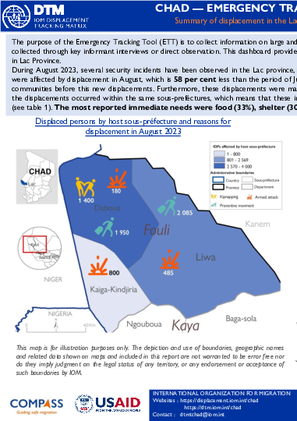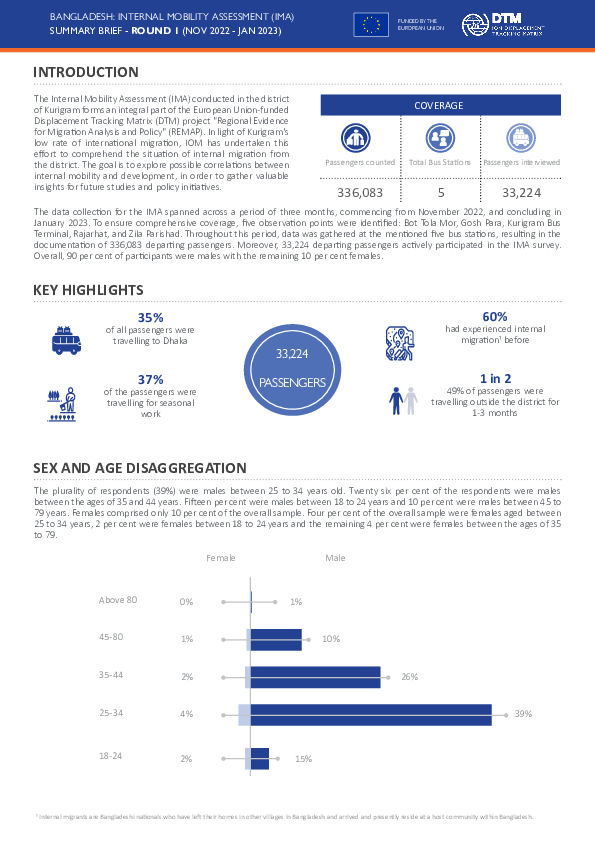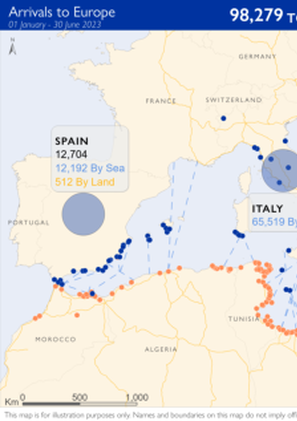-
Countries
-
Data and Analysis
-
Special Focus
-
Crisis Responses

Contact
dtmhaiti@iom.int
Language
English
Location
Haiti
Period Covered
Sep 06 2023
Sep 08 2023
Activity
- Mobility Tracking
- Event Tracking
On 6th September 2023, insecurity related violences erupted in the neighborhood of Solino located in the municipality of Port-au-Prince (West District). In addition to loss of life, these attacks have also caused the displacement of approximatively 1 305 individuals (299 households) who mainly took refuge in the municipalities of Delmas (67%) and Port-au-Prince (28%). Most of IDPs (56%) of IDPs took refuge in host families and 44% in 4 spontaneous sites (2 in the municipality of Port-au-Prince and 2 in Delmas).

Contact
DTM Pakistan, iomisbdtmremapteam@iom.int
Language
English
Location
Pakistan
Period Covered
Aug 16 2023
Aug 31 2023
Activity
- Flow Monitoring
IOM Pakistan collects data on the outflows of Afghan migrants at the Torkham and Chaman border crossing points to better understand the migration movements of Afghan migrants returning to Afghanistan from Pakistan. Between 16 and 31 August 2023, 3,872 Afghan nationals spontaneously returned to Afghanistan, including 1,340 through the Torkham border point and 2,532 through the Chaman border point. Border authorities facilitated the return of 239 individuals due to the lack of legal documentation to remain in Pakistan. Information about these individuals is not included in the count. Although IOM identified 60,036 Afghan returnees (between 1 January - 31 August 2023) at two border crossings, this may not reflect the total number of Afghan returnees. Moreover, for this study, only the head of household or representative of the family were interviewed. This means that the number of interviews conducted by the enumerators is lower than the number of returnees recorded by IOM. Between 16 and 31 August 2023, IOM interviewed 220 respondents
Contact
DTM Libya, DTMLibya@iom.int
Language
English
Location
Libya
Snapshot Date
Aug 31 2023
Activity
- Mobility Tracking
- Site Assessment
Detention Centre Profiling is a component of IOM Libya’s Displacement Matrix programme. It is a data oriented tool that routinely provides specific sex and age demographic data and key sectorial information on individuals held in Libya’s detention centres on the date of assessment.

Contact
DTM Tchad, dtmtchad@iom.int
Language
English
Location
Chad
Period Covered
Aug 01 2023
Aug 22 2023
Activity
- Mobility Tracking
- Event Tracking
The purpose of the Emergency Tracking Tool (ETT) is to collect information on large and sudden population movements as well as on security and climate emergencies. Information is collected through key informant interviews or direct observation. This dashboard provides information on movements which occurred during the period from 01 to 22 august 2023, in Lac Province.
During August 2023, several security incidents have been observed in the Lac province, resulting in thousands of displacements. A total of 1,765 households (6,900 individuals) were affected by displacement in August, which is 58 per cent less than the period of July 2023. It is noteworthy that the majority of these individuals (84%) were members of local communities before this new displacements. Furthermore, these displacements were mainly caused by preventive movement following armed attacks (38%). Indeed, 81 per cent of the displacements occurred within the same sous-preféctures, which means that these individuals took refuge in localities situated in the same sous-préfectures as their provenances (see table 1). The most reported immediate needs were food (33%), shelter (30%), water (20%) and non-food items (17%).

Contact
DTM Tchad, dtmtchad@iom.int
Language
English
Location
Chad
Period Covered
Aug 01 2023
Aug 22 2023
Activity
- Mobility Tracking
- Event Tracking
Le suivi des urgences a pour but de recueillir des informations sur les mouvements importants et soudains, ainsi que sur des urgences sécuritaires et climatiques. Les informations sont collectées par le biais d’entretiens avec des informateurs clés ou par des observations directes. Ce tableau de bord présente les informations sur les mouvements des personnes survenus dans la période du 01 au 22 août 2023 dans la province du Lac.
Durant le mois d’août 2023, plusieurs incidents sécuritaires ont été observés dans la province du Lac engendrant des milliers de déplacements. Au total, 1 765 ménages (6 900 individus) ont été affectés par des déplacements pendant ce mois, soit 58 pour cent de moins comparé à la période de juillet 2023. Par ailleurs, il est à souligner que la grande partie de ces personnes (84%) étaient membres des communautés locales avant leurs déplacements. En outre, ces déplacements ont été principalement causés par les mouvements préventifs dus aux attaques armées (38%). Ainsi, 81 pour cent des déplacements se sont produit à l’intérieur de mêmes sous-préfectures, c’est-à-dire que ces personnes se sont réfugiées dans des localités situées dans les mêmes sous-préfectures que leurs lieux des provenances (voir tableau 1). Les besoins immédiats généralement rapportés ont été les nourritures (33%), les abris (30%), l’eau (20%) et les articles non alimentaires (17%).
- Europe First Arrivals Map - January-June2023
- Europe Migrant Presence Overview Map - as of end of June 2023

Contact
DTM REMAP Support Team (dtmremapsupport@iom.int); DTM REMAP Bangladesh Team (remapbd@iom.int)
Language
English
Location
Bangladesh
Period Covered
Nov 17 2022
Jan 16 2023
Activity
- Survey
- Mobility Tracking
The Internal Mobility Assessment (IMA) conducted in the district of Kurigram forms an integral part of the European Union-funded Displacement Tracking Matrix (DTM) project "Regional Evidence for Migration Analysis and Policy" (REMAP). In light of Kurigram's low rate of international migration, IOM has undertaken this effort to comprehend the situation of internal migration from the district. The goal is to explore possible correlations between internal mobility and development, in order to gather valuable insights for future studies and policy initiatives.

Contact
DTM REMAP Support Team (dtmremapsupport@iom.int); DTM REMAP Bangladesh Team (remapbd@iom.int)
Language
English
Location
Bangladesh
Period Covered
May 12 2022
Jun 08 2022
Activity
- Mobility Tracking
- Baseline Assessment
As the COVID-19 pandemic emerged globally, migrant workers, both internationally and within Bangladesh, found themselves facing a new set of challenges and vulnerabilities. With limited access to income-generating activities, social services, healthcare systems, and social support networks, many have opted to return home. Two years after the first cases of COVID-19 emerged in Bangladesh, the impacts of the pandemic continue to be felt in the country, albeit in smaller waves. During May and June 2022, IOM conducted a third round of data collection, supported by the European Union under the regional program REMAP and in coordination with the Research and Policy unit of the Ministry of Expatriates’ Welfare and Overseas Employment, Bangladesh, along with the NPM team based in Cox’s Bazar, to further enhance the understanding of economic impacts and relevant challenges related to COVID-19 in Bangladesh while focusing on a longitudinal perspective and analysis.

Contact
DTM Niger, DTMNiger@iom.int
Language
English
Location
Niger
Period Covered
Aug 01 2023
Aug 15 2023
Activity
- Flow Monitoring
L’OIM, à travers l’outil de suivi des flux de populations (Flow Monitoring en anglais) de la Matrice de suivi des déplacements (Displacement Tracking Matrix, DTM en anglais), récolte des données à des points d’entrée, de sortie et de transit clés afin de mieux comprendre les mouvements de populations à travers l’Afrique de l’Ouest et du Centre. Le suivi des flux de population est une activité qui permet de quantifier et de qualifier les flux et tendances de mobilités, les profils des migrants, et les expériences et routes migratoires. Ce rapport est fait à base des données collectées du 1 er au 15 août 2023.
Contact
DTM Sudan, DTMSudan@iom.int
Location
Sudan
Activity
- Mobility Tracking
- Baseline Assessment
Period Covered
May 19 2023 -Sep 02 2023
From 15 April 2023, armed clashes erupted between the Sudanese Armed Forces (SAF) and the Rapid Support Forces (RSF). As a result of the military clashes, DTM Sudan estimates that 4,075,930 Individuals (814,518 Households) have been recently internally displaced. The IDP caseload has been observed in all of Sudan’s in 3,733 locations across all of Sudan’s 18 states.1 The highest proportions of IDPs have been observed in River Nile (12.24%), South Darfur (11.93%), East Darfur (11.47%), Northern (8.93%), Sennar (7.87%), and North Darfur (7.17%).
Field teams report that the IDPs observed were originally displaced from eight states. The majority (2,820,325 IDPs, 69.19%) have been reportedly displaced from Khartoum state; followed by South Darfur (14.86%),North Darfur (7.99%), Central Darfur (3.71%), West Darfur (3.24%), South Kordofan (0.56%), North Kordofan (0.44%), and Aj Jazirah (0.01%). DTM Sudan also estimates that approximately 2.66% of the IDP caseload are non-Sudanese nationals. In addition to the internal displacement, the conflict in Sudan has caused the Mixed Cross-Border Movements of 1,104,360 individuals into neighbouring countries namely Egypt, Libya, Chad, Central African Republic, South Sudan and Ethiopia. 67% of arrivals tracked in those countries were Sudanese nationals and 33% estimated foreign nationals and returnees. The majority of arrivals were reported in Chad (42.1%), Egypt (25.8%),
and South Sudan (22.9%).
Population Groups
Survey Methodology
Unit of Analysis Or Observation
Type of Survey or Assessment
Keywords
Geographical Scope
Administrative boundaries with available data
The current dataset covers the following administrative boundaries
